A new section of Taipei City bike path will open soon along the southern bank of Jingmei River (景美溪). Discovery of this missing link by members of Skeleton Crew, a Taipei-based group of cyclists that grew out of off-season training by dragon boat racers, reignited debate about how many kilometers of bike path there now are in Taipei.
Their guesstimates ranged from 60 to almost 400 kilometers, though calculations used different criteria and definitions. Some said “Taipei means Taipei City,” others that this would be silly since it was too easy to cross unknowingly into New Taipei City, Keelung City or even Taoyuan County.
Yet others raised the problem of non-contiguous sections, such as short lengths along the north coast or that along Daiyujue River (逮魚崛溪) in New Taipei City’s Pinglin District (坪林), which, passing blossoming banks and echoing with birdsong, is often touted as the area’s nicest ride. This led to debate about the relative aesthetic merits of various rides, and best places to stop for snacks, meals and beverages.

Photo: Mark Caltonhill
Map apps were downloaded, estimates revised but, ultimately, it was decided there was only one way to measure the entire network: the Skeleton Crew would cycle a route along all the rivers in and around the Taipei area that was contiguous and never doubled back on itself.
Normally the Skeleton Crew wouldn’t consider riding riverside bike paths on weekends when they teem with other cyclists, many on rentals and YouBikes, often in large groups chatting or veering randomly and stopping suddenly, never imagining there might be 100 kilograms of lycra-and-steel hurtling behind them at 30kph.
And so it should be, because the riverside bike paths are a wonderful way for non-cyclists to get a safe taste of this healthy, economic, convenient, non-climate-change-gas-emitting means of transportation. After all, one of the key reasons many people don’t take up cycling is the perceived danger of sharing roads with speeding cars and trucks.
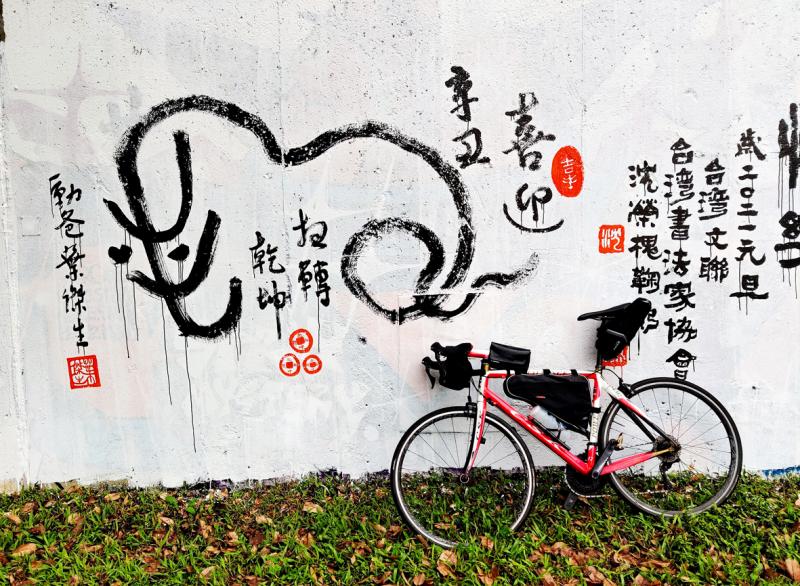
Photo: Mark Caltonhill
TAIPEI
It can be hard to remember now that until a decade ago almost nobody in Taiwan cycled. That this has changed owes a great deal to the if-you-build-it-they-will-come planning attitude of the Taipei City Government in the 1990s. The first few kilometers opened in 2002 and have been expanding ever since, as have the numbers of users, meaning that groups like Skeleton Crew keep well away on weekends and summer evenings.
But two months of heavy rains at the end of last year were followed by a biting cold front at New Year, and so Jan. 3 was chosen since it would allow group members with weekday jobs to participate too.
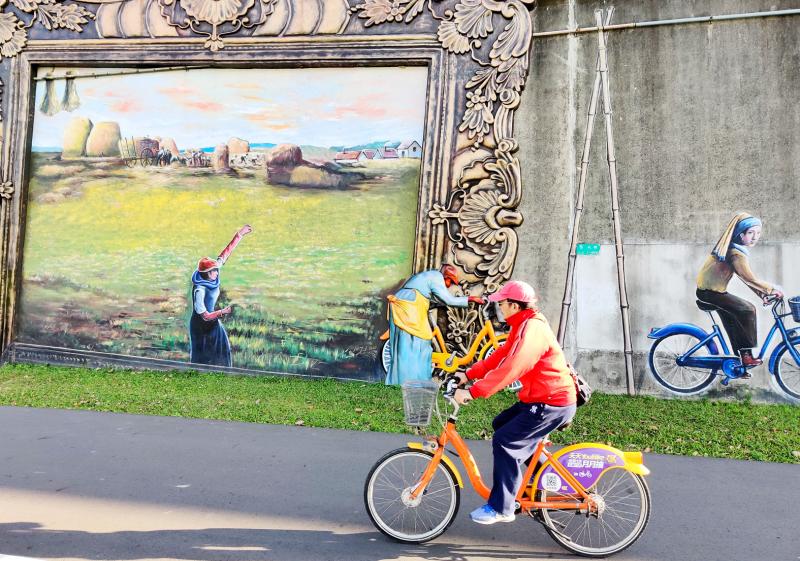
Photo: Mark Caltonhill
Predawn saw eight cyclists gathering at the Pipe Live Music venue near Taipei’s Gongguan (公館), where remnants of Saturday night’s revelers were still downing their last beers as bar staff finished clearing tables and chairs away.
Everyone was well wrapped up, although it was not nearly as cold as on previous days. Among the eight, five were regular members and three were friends or nosey journalists; countries represented included Taiwan, Japan, England, Scotland, Thailand and the US.
Barely had they set off northward along the Sindian (新店溪) and Tamsui (淡水河) rivers, than the day’s first and last puncture announced itself with a mighty hiss. Quickly fixed under light from the others’ headlamps, the eight resumed their journey, soon rounded the “duck’s bill” at the tip of Shezidao (社子島), and turned east along Keelung River (基隆河).
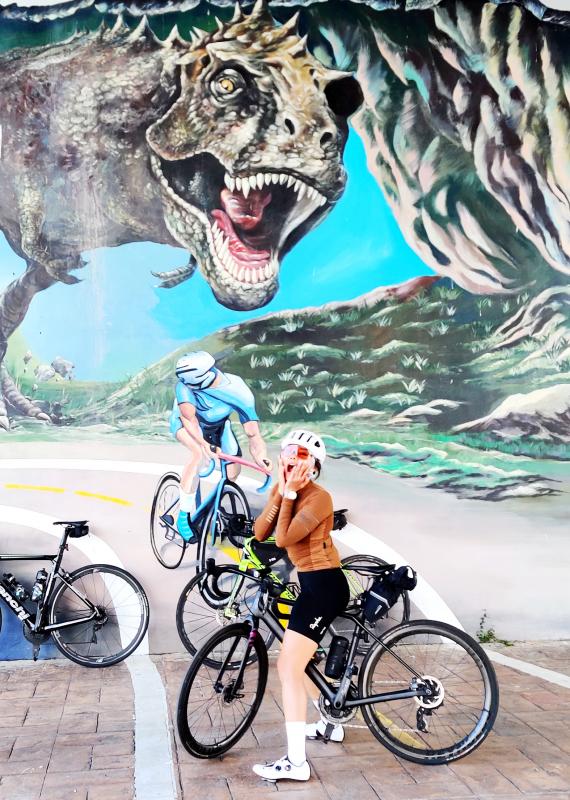
Photo: Mark Caltonhill
Most of the riverside bike paths run next to tall, white levees, certain sections of which have been designated as graffiti zones. One such is just before Nangang District (南港), where a calligraphic club regularly executes classical texts and ink-wash paintings. Their recent works, relating to the upcoming Year of the Ox, were greatly superior to most seen throughout the rest of the day.
KEELUNG AND NEW TAIPEI CITY
Entering Keelung City through a disused railway tunnel marked the cyclists’ easternmost limit, after which they crossed the river and turned back. There being no bike path along the northern bank, the Skeleton Crew followed the road nearest the river, before stopping for brunch in Sijhih District (汐止), New Taipei City.
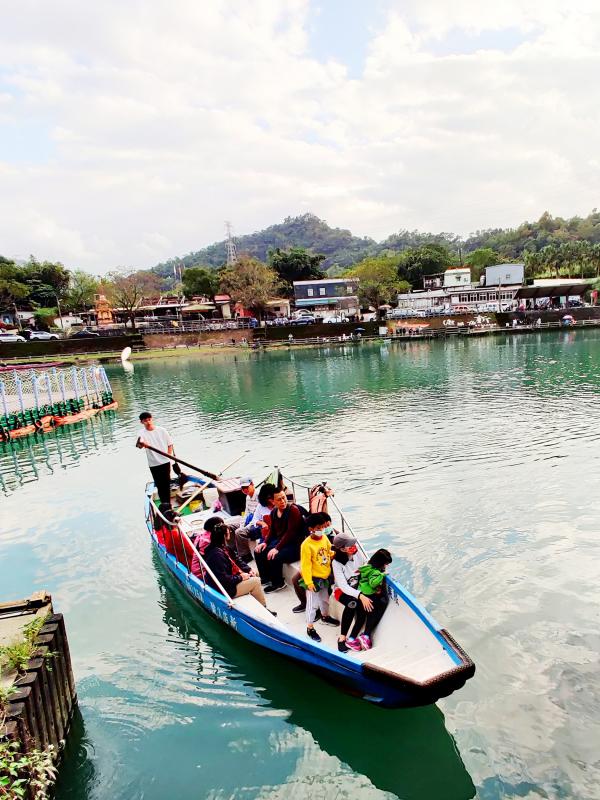
Photo: Mark Caltonhill
Egg pancakes and soy milks consumed, they continued westward, past Neihu District (內湖) and Yuanshan, before taking a short detour up Waishuang River (外雙溪). All around them, the riverside park was filling with basketball players, tangoing dancers, taichi practitioners and, of course, increasing numbers of families trundling along on all manner of cycles.
Coffee was taken in the Guandu area (關渡) followed, after riding the ferry from Tamsui to New Taipei City’s Bali District (八里), by doughnuts. The group then headed southward, past Wugu District (五股) and around Sanchong District (三重), before heading westward up Dahan River (大漢溪) to Yingge (鶯歌) and Dasi (大溪) districts, their westernmost point.
One additional pleasure of riding the riverside paths is that it takes one back a century or more to before the construction of the railways and many roads, when rivers provided the main transportation links. Pottery was thus delivered down the Dahan from Yingge, stinky tofu along the Jingmei from Shenkeng District (深坑) and Aboriginal goods down the Nanshi (南勢) and Sindian rivers from Wulai District (烏來).
There being no bike path on the southern bank of Dahan River from Dasi, for a second time the Crew had to take to public roads, using about 15 kilometers of Provincial Highway 3 to get onto Sansia River (三峽溪) and back to the Dahan at Tucheng District (土城).
Progress was good until they rejoined Sindian River at Yonghe District (永和), where the throngs of beginner bikers, kite-flying children, dogs off leashes, selfie-takers and all of humankind at play brought their speed down to little more than a crawl down to the Bitan (碧潭) scenic area and back up the other side. Only the new, as-yet-undiscovered, section along Jingmei River brought some relief.
Finally, just after dusk, they arrived at their starting point, The Pipe. Beers were bought, a toast was made, glasses were drained and the distance discussed.
AND THE TOTAL IS...
It was probably around 230 kilometers, less about 20 kilometers of road, giving Greater Taipei a total of around 210 kilometers of almost-contiguous riverside bike paths. Maybe they should ride it again to check, someone suggested, but definitely not on a weekend.
Mark Caltonhill bikes, and writes, and writes about bikes.

We lay transfixed under our blankets as the silhouettes of manta rays temporarily eclipsed the moon above us, and flickers of shadow at our feet revealed smaller fish darting in and out of the shelter of the sunken ship. Unwilling to close our eyes against this magnificent spectacle, we continued to watch, oohing and aahing, until the darkness and the exhaustion of the day’s events finally caught up with us and we fell into a deep slumber. Falling asleep under 1.5 million gallons of seawater in relative comfort was undoubtedly the highlight of the weekend, but the rest of the tour

Youngdoung Tenzin is living history of modern Tibet. The Chinese government on Dec. 22 last year sanctioned him along with 19 other Canadians who were associated with the Canada Tibet Committee and the Uighur Rights Advocacy Project. A former political chair of the Canadian Tibetan Association of Ontario and community outreach manager for the Canada Tibet Committee, he is now a lecturer and researcher in Environmental Chemistry at the University of Toronto. “I was born into a nomadic Tibetan family in Tibet,” he says. “I came to India in 1999, when I was 11. I even met [His Holiness] the 14th the Dalai

Following the rollercoaster ride of 2025, next year is already shaping up to be dramatic. The ongoing constitutional crises and the nine-in-one local elections are already dominating the landscape. The constitutional crises are the ones to lose sleep over. Though much business is still being conducted, crucial items such as next year’s budget, civil servant pensions and the proposed eight-year NT$1.25 trillion (approx US$40 billion) special defense budget are still being contested. There are, however, two glimmers of hope. One is that the legally contested move by five of the eight grand justices on the Constitutional Court’s ad hoc move
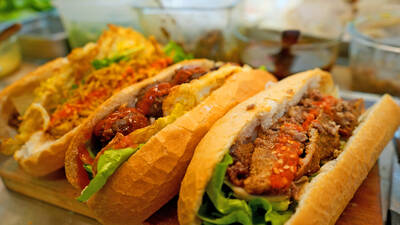
Stepping off the busy through-road at Yongan Market Station, lights flashing, horns honking, I turn down a small side street and into the warm embrace of my favorite hole-in-the-wall gem, the Hoi An Banh Mi shop (越南會安麵包), red flags and yellow lanterns waving outside. “Little sister, we were wondering where you’ve been, we haven’t seen you in ages!” the owners call out with a smile. It’s been seven days. The restaurant is run by Huang Jin-chuan (黃錦泉), who is married to a local, and her little sister Eva, who helps out on weekends, having also moved to New Taipei